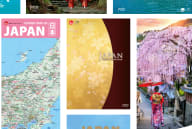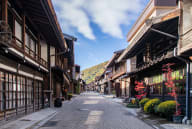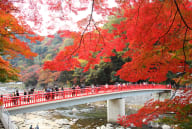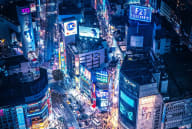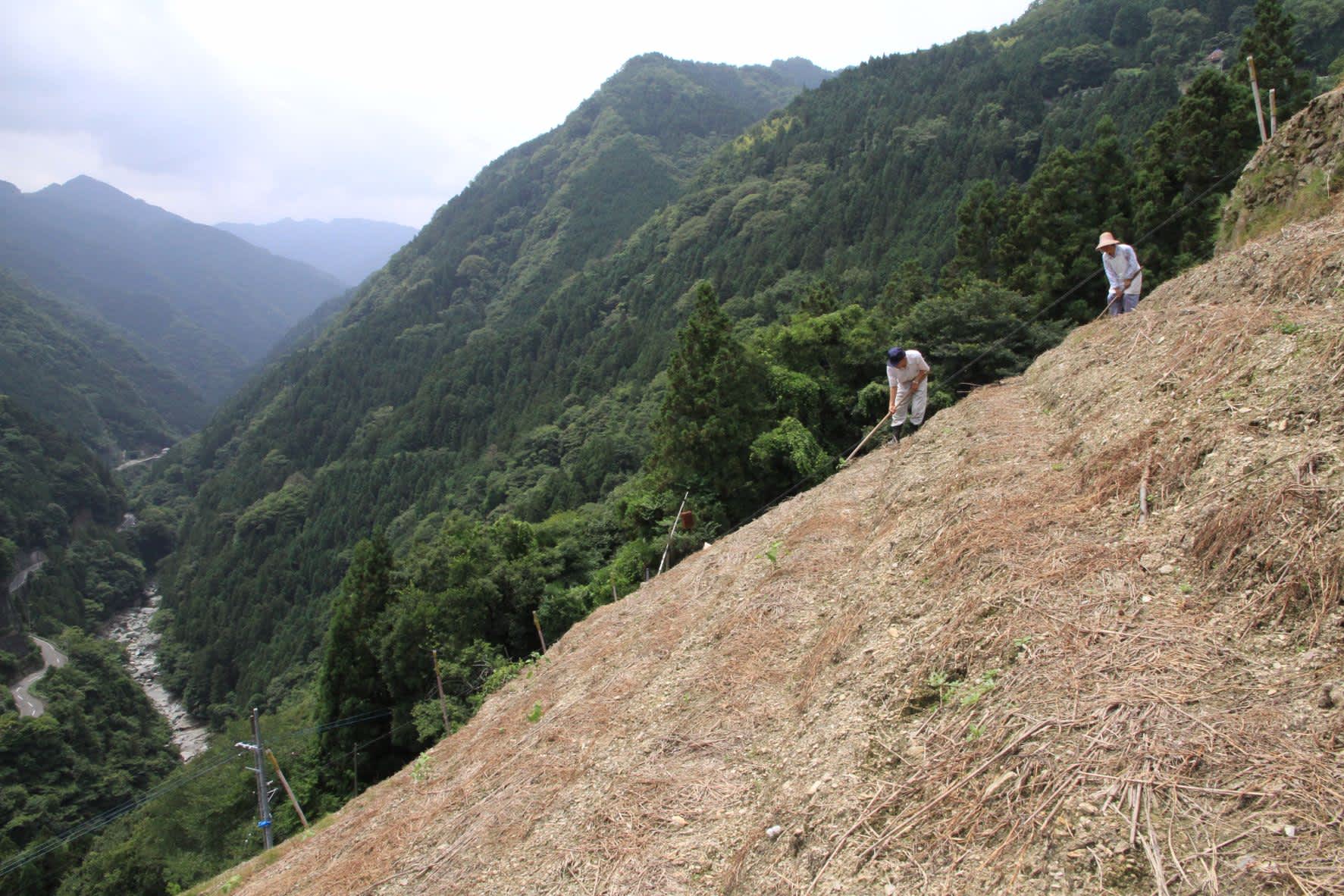
Within the mountainous region of Shikoku, we discover the unvarnished gems that make up a culturally immersive adventure into rural Japanese life. Far from the cacophony of the cities, lies remote towns spread across the Iya Valley. The most authentic ways to connect with the land for a real taste of place is through a Farm Stay and Spiritual Pilgrimage that offer a deep dive into Old World Japanese traditions.
Lush forests drape the mountainside of Tokushima Prefecture. Ancient bridges of twined-wood and rope-like-vines cross pristine rivers in Miyoshi and Oboke. Thatch-roofed houses dot the landscape and reflect a simpler time. In Ochiai Village, impossibly steep agricultural fields scale up the mountain slopes. The air is crisp and we can see for miles, but there’s no room here for vertigo.
We rise early from our comfy futons that had been laid out for us on tatami and, following a warm nourishing breakfast of local fish and vegetables, we set out of for the fields. We typically think of farm land as flat and level, but necessity is the mother of invention, so these fields are farmed on a vertical, and our challenge is to stay upright. We’re assigned organically grown vegetables to pick, like sweet potatoes and kabocha pumpkins, eggplants and mountain vegetables, peanuts, shiso and tealeaves. Calm, exhilarating, and with a refreshing feeling of accomplishment, we collect beautiful produce to bring back to the village.

For lunch we reap our harvest and cook up a fresh tempura fry. In the afternoon we leisurely sip tea from what we’d picked just hours before and weave together traditional baskets. The exercise of this craft, itself, is meditative. Our next activity, River fishing, is yet another exercise in contemplation and serenity. We balance on rocks in the rushing glistening water while reeling-in the abundant local amego fish. Skewered with a bamboo stick, our catch is then encrusted in salt and, along with miso-lacquered soba balls and tofu, cooked over a fire pit.
What is Japanese cuisine without rice? Since the mountains are so steep, there is no rice cultivation. Instead, locals harvest whole grains for soba, and prepare nurturing bowls of soup with hand-ground soba and fresh mountain vegetables.

Traditional cooking techniques have also had to conform to the mountainside. We sit around a fire with a large flat river rock suspended above, which serves as the stove top. On it, our host builds a retaining wall of miso paste. Within this oblong circle, he places dense potatoes, tofu, konyaku, shishito peppers, onions and the fish, which all slow-cook together for our feast. Awed by the ingenuity of this technique, the simplicity and wholesome freshness of the ingredients, we feel completely replenished.

Across Shikoku, the quality of cuisine is very high. Kagawa is Japan’s capital of udon noodles. Udon Taxis driven by udon specialists whisk us away to the best restaurants to indulge in these bowls of bliss. Kagawa is also home to the famed Sanuki Olive Wagyu. Purebred Kagawa cattle are drawn to the caramel scent emitted from the sugars of dried olives, and eat 300 of them every day. The texture of this beef is exquisite, uniquely elegant, and rounds my palate as though it was marinated in a pure olive oil with harmonious sensations of soft walnut and fresh artichoke.
Chicken in Shikoku is clucking delicious! Never in my life have I tasted such tenderness. The local Awa-o-dori is firm and juicy beyond compare. The reddish meat is lean and chewy and has high levels of umami. Senzanki fried chicken from neighbouring Ehime Prefecture is also addictive. You just cannot beat this quality bird. There must be something in the water. With our palates are satisfied, the river calls.
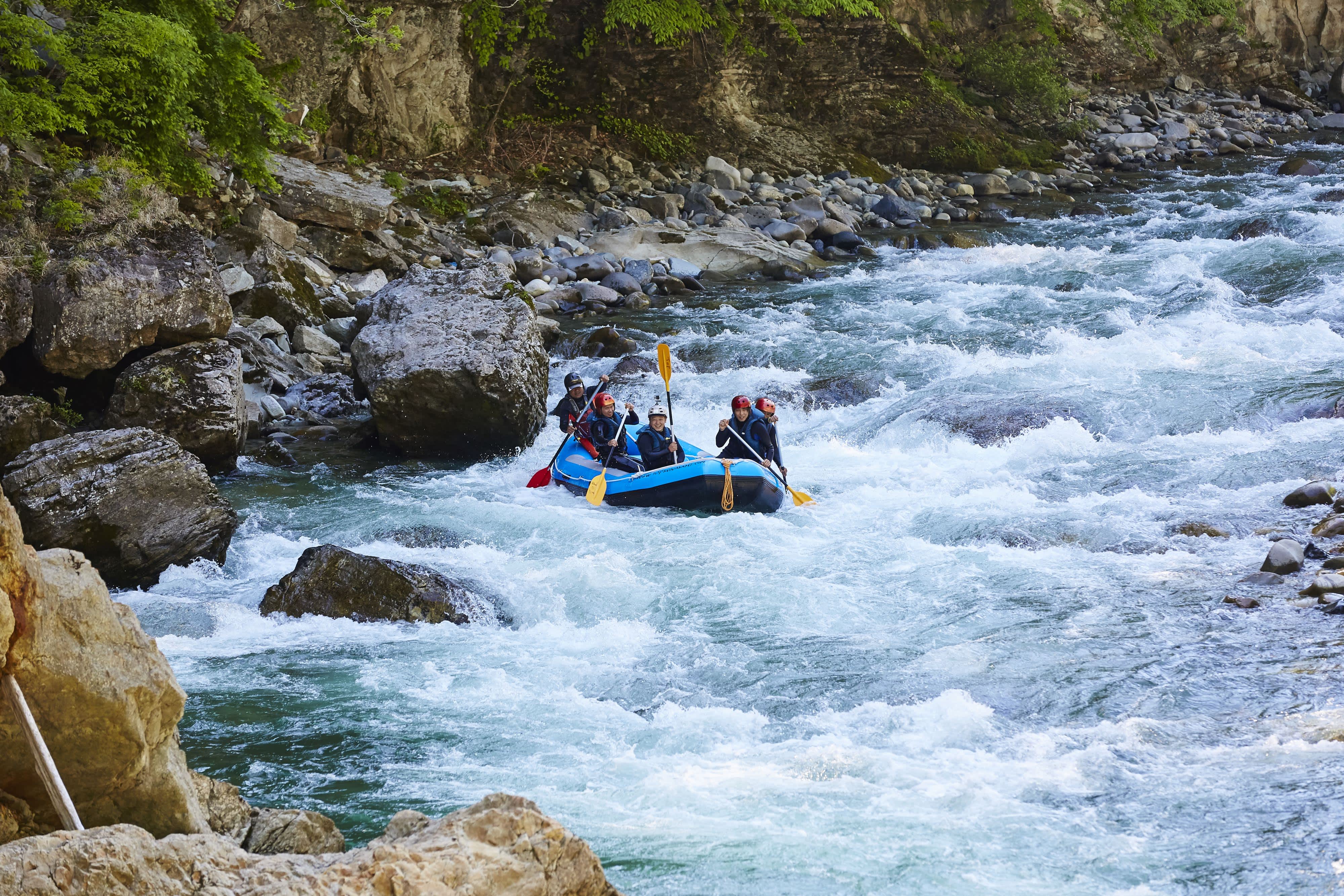
Not-to-be missed are the roaring rapids below. The best whitewater rafting in Japan is in the Yoshino River. It’s world-renowned for thrill seekers, but there is more tame family section, too. Ferociously hurtling down river, winding through the majestic mountain range at Mach speed, the rush of torpedoing this emerald green water is fantastic! Also available from Happy Raft are canyoning expeditions that repel down cliffs. We tree-walk to a zipline across the canyon, then slide down a waterfall into a deep pool and lazily drift with the current.
This is a spiritual land. With all its majesty, how could it not be? A Shikoku Pilgrimage follows the 1,400 km route of the 9th Century Shingon Buddhist monk, Kobo Daishi, to 88 temples along the ocean sides and mountains. With staff in hand and donning a white vest, pilgrims are welcomed in cities, towns and villages to remote shrines with enchanting vistas.
From tilling the soil, to scaling the peaks, to rafting the rivers, touring the island of Shikoku reveals a surprising array of exhilaration and flavour, and redefines steep one step at a time.
About the writer
Adam Waxman is the Publisher of DINE and Destinations magazine, and has written for several travel guides from Fodor’s to Lonely Planet. Adam has lived and worked in Kyoto and Tokyo, and is passionate about Japan travel. For 2 consecutive years, he has been appointed by the Commissioner of Japan Tourism Agency, the Ministry of Land, Infrastructure and Tourism, as the member of Advisory Board.
The opinions expressed in the above article do not reflect the views of JNTO. All content and images are property of the writer unless otherwise specified.
* This article is based on the writer’s experience before COVID-19.


















































